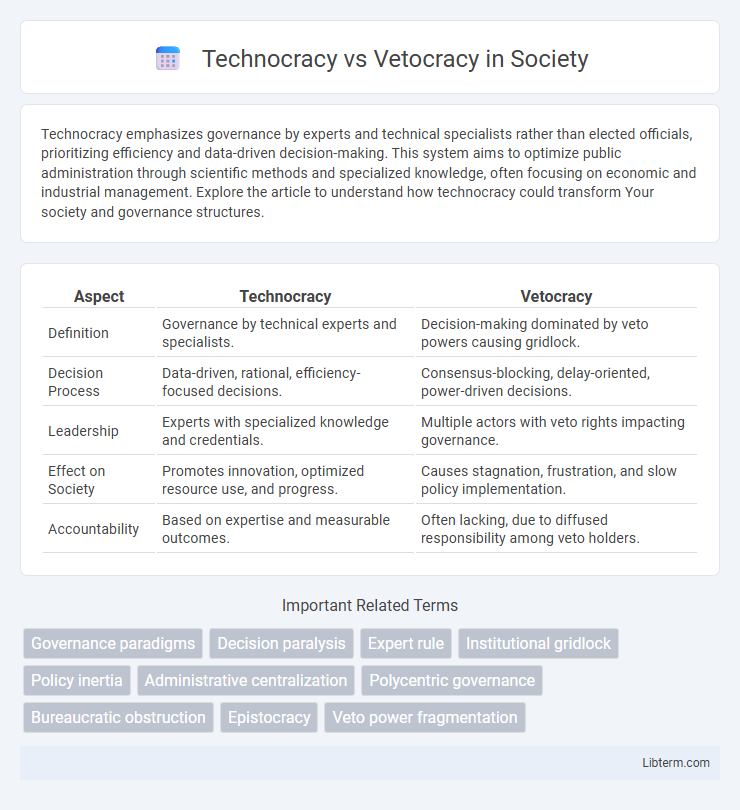Technocracy emphasizes governance by experts and technical specialists rather than elected officials, prioritizing efficiency and data-driven decision-making. This system aims to optimize public administration through scientific methods and specialized knowledge, often focusing on economic and industrial management. Explore the article to understand how technocracy could transform Your society and governance structures.
Table of Comparison
| Aspect | Technocracy | Vetocracy |
|---|---|---|
| Definition | Governance by technical experts and specialists. | Decision-making dominated by veto powers causing gridlock. |
| Decision Process | Data-driven, rational, efficiency-focused decisions. | Consensus-blocking, delay-oriented, power-driven decisions. |
| Leadership | Experts with specialized knowledge and credentials. | Multiple actors with veto rights impacting governance. |
| Effect on Society | Promotes innovation, optimized resource use, and progress. | Causes stagnation, frustration, and slow policy implementation. |
| Accountability | Based on expertise and measurable outcomes. | Often lacking, due to diffused responsibility among veto holders. |
Understanding Technocracy: Definition and Principles
Technocracy refers to a system of governance where decision-makers are selected based on their expertise in science, technology, and specialized knowledge rather than political power or popular vote. Key principles of technocracy include evidence-based policymaking, efficiency, and reliance on technical experts to guide government and industry decisions. This model emphasizes rationality, data-driven solutions, and prioritizing innovation to solve complex societal problems.
Exploring Vetocracy: Meaning and Origins
Vetocracy refers to a system where decision-making is hindered by excessive use of veto powers, leading to gridlock and inefficiency. Originating from the Latin word "veto," meaning "I forbid," vetocracy describes political or organizational environments where competing interests block progress. This contrasts with technocracy, which prioritizes expert-driven governance based on technical knowledge and data.
Key Differences Between Technocracy and Vetocracy
Technocracy centers decision-making power in experts and technical specialists, promoting efficiency and evidence-based governance, while vetocracy creates a system where numerous stakeholders have veto power, often leading to gridlock and indecision. Technocracy emphasizes expertise and data-driven solutions, whereas vetocracy prioritizes preventing unilateral actions through dispersed authority that frequently hampers progress. The key difference lies in technocracy's focus on expertise-led leadership versus vetocracy's reliance on mutual veto rights that can obstruct policy implementation.
Historical Examples of Technocratic Governance
Historical examples of technocratic governance include the Soviet Union under Lenin and Stalin, where experts in economics and industry directed state policies to modernize the economy and increase productivity. Similarly, Singapore under Lee Kuan Yew implemented technocratic principles by employing skilled civil servants to drive rapid economic development and urban planning. These cases illustrate how technocracy prioritizes expert knowledge and rational planning to address complex societal challenges and foster efficient governance.
Notable Instances of Vetocratic Systems
Vetocratic systems often emerge in political contexts where powerful groups or institutions hold veto power to block decisions, as seen in the United Nations Security Council, where five permanent members can prevent resolutions despite majority support. These systems create gridlock in governance, exemplified by the European Union's consensus-based decision-making, which can stall reforms due to the need for unanimity among member states. The persistent use of veto rights in these frameworks highlights challenges in achieving efficient collective action and showcases the tension between inclusivity and decisiveness in global governance.
Advantages and Drawbacks of Technocracy
Technocracy offers advantages such as decision-making by experts, leading to efficient and data-driven policies that can enhance innovation and economic growth. However, its drawbacks include potential lack of democratic accountability and public engagement, which may result in technocratic elitism and reduced transparency. Balancing technical expertise with inclusive governance remains a critical challenge for technocratic systems.
Strengths and Weaknesses of Vetocracy
Vetocracy empowers diverse stakeholders to check proposals, promoting balanced decision-making and preventing autocratic rule, which strengthens democratic processes. However, its excessive use of veto power can lead to gridlock, slow policy implementation, and hinder necessary reforms, weakening governance efficiency. The system's reliance on consensus often results in compromise solutions that may dilute effective action or innovation.
Impact on Policy-Making: Efficiency vs. Gridlock
Technocracy emphasizes expert-driven decision-making, leading to more efficient policy formulation based on scientific data and specialized knowledge. Vetocracy relies on multiple stakeholders' veto powers, often causing gridlock and slowing legislative progress by requiring broad consensus. This structural difference critically impacts the speed and effectiveness of policy implementation.
Technocracy and Vetocracy in Modern Governments
Modern governments influenced by technocracy prioritize expert knowledge and data-driven policies to enhance efficiency and rational decision-making, often relying on specialists in science, engineering, and economics. Vetocracy, in contrast, manifests through excessive veto powers and bureaucratic gridlock, where multiple stakeholders or institutions possess the ability to block policies, leading to governance paralysis. The tension between technocracy's streamlined expertise and vetocracy's fragmentation shapes contemporary political dynamics and policy outcomes worldwide.
Future Prospects: Navigating Between Technocracy and Vetocracy
Future prospects in governance hinge on balancing technocracy's data-driven efficiency with vetocracy's emphasis on consensus and stakeholder approval, which can either propel innovation or stifle decision-making. Advances in artificial intelligence and algorithmic policy design enhance technocratic capability to address complex societal challenges, while vetocracy's inclusive frameworks aim to safeguard democratic legitimacy and prevent unilateral control. Navigating between these systems requires adaptive institutional models that integrate expert insights with participatory mechanisms to foster both effective and legitimate governance.
Technocracy Infographic

 libterm.com
libterm.com